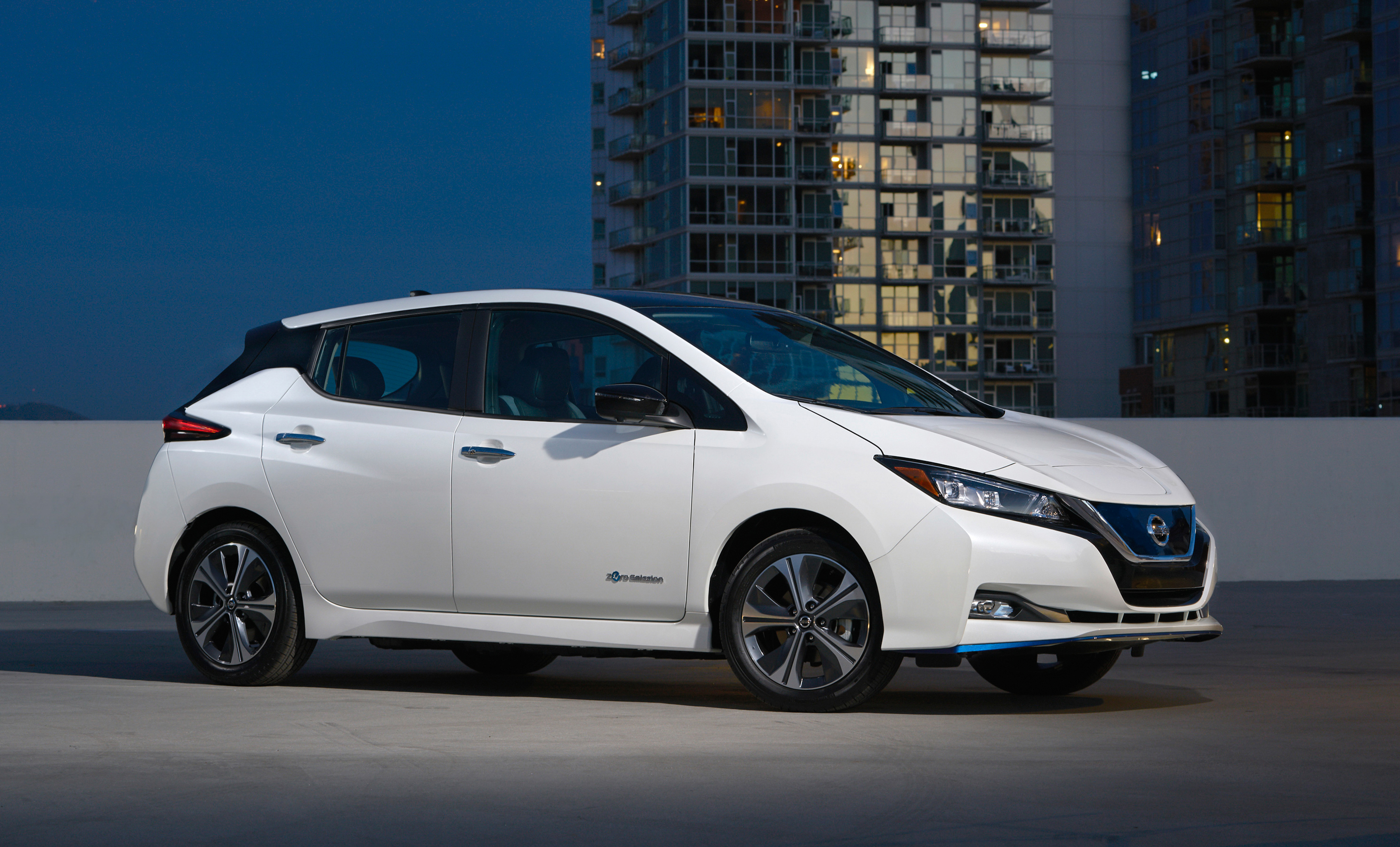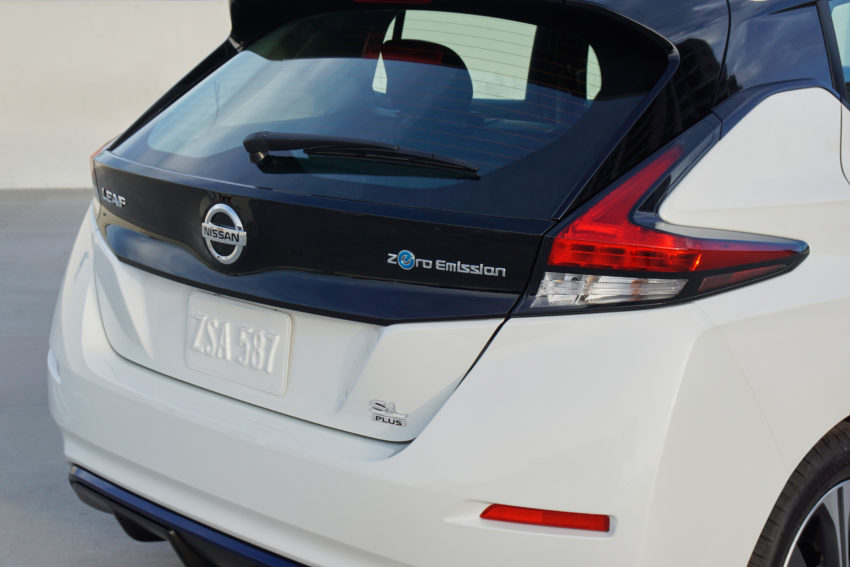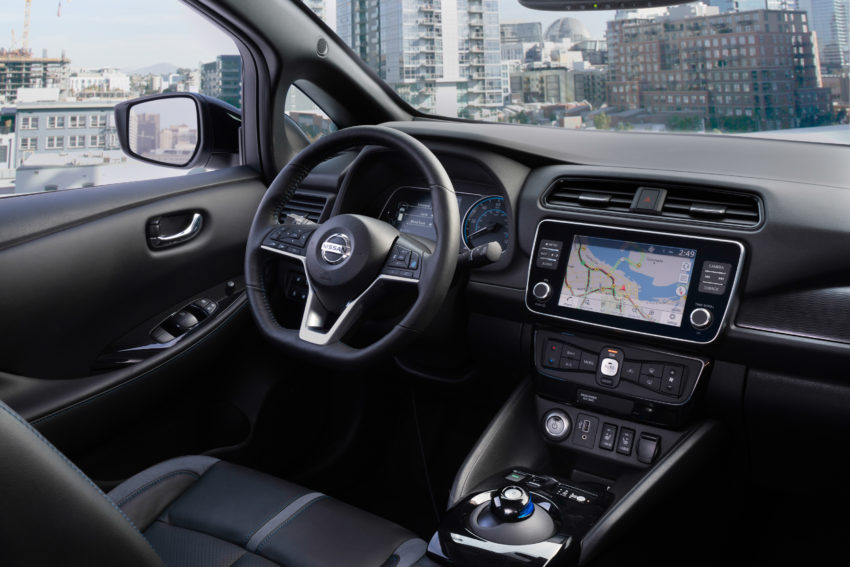
(Updated 3/1/19 to include Leaf Plus pricing and base Tesla Model 3 comparative data.)
It’s taken a while, but Nissan finally has joined the 200-mile EV club with its 2019 Leaf Plus.
The Leaf Plus adds 50 percent more battery cells, 51 percent more range and 46 percent more horsepower to Nissan’s standard Leaf.
It will join the lineup with three trim levels in early March. Pricing, efore incentives, starts at $37,445 including Nissan’s mandatory $895 delivery charge.
[Estimated Reading Time: 8 min.]
That keeps it competitive with the 238-mile Chevrolet Bolt and the 258-mile Hyundai Kona EV. Both start at $37,495. The new 220-mile Tesla Model 3 “Standard Range” starts at $35,000.
All of those prices are before applicable federal, state and local incentives.
On the Road
Visually, equipment-wise and on the road, there’s not a lot of difference between the 2019 Leaf Plus and the previously reviewed standard Leaf – but there’s enough.
To keep things easier, we’ll refer to the Plus and standard Leafs by their battery capacities. The Plus is the 62-kWh leaf and the standard model is the 40 kWh Leaf.
First, of course, comes range. The 40 kWh Leaf is rated at up to 150 miles and hews pretty close in everyday use. Range drops 10-20 percent as highway speeds and passenger and cargo loads increase. Extreme cold has an even greater impact.
The 62 kWh Leaf is rated at up to 226 miles, and in a test drive that covered about half that distance it seemed to be sticking pretty close to the EPA estimate – with all the same weight, speed, terrain, driving style and ambient temperature caveats that apply to any EV.
Official EPA estimates aren’t out yet, but Nissan has said it expects the heavier SV Plus and SL Plus trims, with their larger 17-inch wheels and tires, to be rated at up to 211 miles, with the 226-mile rating reserved for the base S Plus trim.
The second big difference is power.

The 62 kWh Leaf Plus’ 214 horsepower electric motor – up from 147 ponies in the 40-kWh model – provides plenty of oomph for quick takeoffs and for peppy passing.
No one buys a Leaf for its prowess on the track, but that extra power translates into a full one-second improvement in 0-60 times; 7 seconds versus 8 seconds for the 40 kWh Leaf. Those are Nissan’s numbers – we didn’t test it on our drive. But the Leaf Plus definitely feels quicker than its 40-kWh stablemate.
TheGreenCarGuy put the 2019 Leaf Plus through its paces on a 111-mile drive in San Diego County, on one of the few mostly sunny days Southern California’s had this winter.
The extra power was especially welcome when passing, particularly on uphill grades. Floor it at 65 and you hear the electric motor spool up and feel the seat back pushing against you as the Leaf Plus jumps forward. Nissan says the 62 kWh models will cover a 50 to 75 mph print a full 53 feet sooner than the 40 kWh. That’s about 3 car lengths.
The Leaf Plus carries more weight, thanks to its larger battery, and it has a slightly lower center of gravity. So, the ride is a bit more planted.
The suspension is a bit stiffer to handle the extra weight, so the ride is firmer, but not uncomfortable. There’s a tad less body roll on corners.
Like the 40 kWh models, the 62 kWh Leaf Plus is fun to drive if you push it. And like its stablemate, the Plus makes driving for the daily commuter a less stressful chore than before.
Master the e-Pedal mode and you almost forget you are in a single-gear electric car when driving the new Leaf on twisting roads – the boost in regenerative braking acts to slow the car jut as would a nicely times downshift. In city driving or in traffic jams, the e-Pedal mode allows the car to come to a complete stop, time after time, without use of the brake pedal.
Nissan’s ProPilot Assist system – standard on the top SL trim, part of a package on the SV – can make long drives a lot more bearable if you are on a well-marked highway. It helps reduce fatigue and greatly reduces the chances of rear-ending the car in front of you or cutting off or sideswiping cars in adjacent lanes.
Making it Go
The 2019 Leaf Plus offers a larger lithium-ion battery pack with 288 cells instead of the regular Leaf’s 192 cells.
For the energy geeks among us – each cell offers a 3 percent increase in energy density. Nissan also figured out a way to package the cells – in three rows instead of two – that lowers resistance for even more power output.
The Leaf Plus battery represents a 55 percent increase in energy density with only a 50 percent increase in the number of cells from the 40-kWh model.
The horsepower increase comes from the battery’s extra density and a revamped power inverter – the electric drive motor (also called a traction motor) is the same size and weight as in the 150-mile model.
2019 Leaf Plus’ single-speed reduction-gear transmission was beefed up a bit, though, to handle the extra power it must transmit to the front wheels.
The larger battery pack adds 290 pounds to the Leaf Plus. Nissan uses heftier springs to handle the weight, increasing ground clearance by about a quarter of an inch. But the battery pack is thicker than the standard Leaf’s – by 1.6 inches (40 mm). That, minus the extra ground clearance, puts the center of gravity about 1.4 inches lower than the 40 KWh Leaf’s, for a slight handling improvement on the curvy stretches.
Charging
The 2019 Leaf Plus has a new 70 kW capacity (100 kW peak) quick charge system – versus 50 kW on the standard 2019 Leaf. And it is standard on all three trim levels
The extra intake capacity means it can get an 80 percent “refill” at a 100 kw Level 3 quick charge station in about the same time – 45 minutes or so – as the standard Leaf. (The Leaf Plus will be able to accept power at 100 kW for only a brief amount of time before settling back to a default charging rate of 70 kW.)
Charging at home on a 240-volt Level 2 system will take up to 11.5 hours, versus 7.5 hours for the standard Leaf.
Pricing and Features
Like the standard Leaf, the 2019 Leaf Plus will come in three trims, S Plus, SV Plus and SL Plus. The S Plus starts at $37,445, the SV Plus at $39,405 and the SL at $43,445.
Standard features on the Leaf Plus trims are for the most part the same as for the regular Leaf trims.

One difference is that the Leaf Plus gets an 8-inch infotainment touchscreen with icon-based interface, customizable home screen and free over-the-air software updates. Apple CarPlay and Android Auto compatibility are standard across the three Plus trims.
Additionally, all 2019 Leaf Plus trims provide a 120/240-volt charging cord-set that’s an $1,111 option on the regular S and SV trims, as well as a standard quick-charge port that’s a part of a $1,590 package on the regular S trim.
Outside, the only things differentiating the Plus models from the standard Leaf are a “Plus” emblem on the rear lift gate, a blue-lighted “e+” symbol in the charging port and a bit of blue trim at the bottom outside edges of the front bumper.
Who’s it For?
With more than 380,000 Leafs sold globally – 130,000 in the U.S. – since its launch at the end of 2010, the Leaf is a well-known and widely accepted nameplate in the EV market. The Leaf Plus adds more range and power without any sacrifices.
It’s selling point versus the 40 kWh Leaf lineup will be range, and the competitive set is fairly small. The “standard” Tesla Model 3, Chevrolet Bolt and Hyundai Kona EV are the only other non-luxury electric cars with comparable range and price.
The Leaf Plus’ estimated range is a tad more than the base Model 3’s, and falls a bit short of the Bolt’s. the Kona EV beat it by 32 miles. But the differences aren’t huge and shouldn’t be a deal breaker for most people.
The 2019 The Leaf Plus has the largest rear cargo area, at 24 cubic feet. The Model 3 trails at 15 cubic feet, versus 17 cubes for the Bolt and 19 for the Kona.
But with rear seats down, the Bolt jumps into the lead with 56 cubic feet and the Leaf trails at just 30 cubic feet. It gains so little because the seats don’t fold flat with the cargo floor. They hump up and fill most of the space that a flat-folding seat would make available.
With 214 horsepower and 250 pound-feet of torque, the Leaf Plus offers more ponies but a bit less grunt than its two chief competitors. The Bolt is rated at 200 hp and 266 lb-ft, while the Kona comes in at 201 hp and 290 lb-ft. Figures for the base Model 3 aren’t yet available but both horsepower and torque are likely to lead the pack.
The Leaf Plus and Kona EV boast top speeds of about 100 mpg, the Tesla tops out at 130 mph. The Bolt is limited to 91 mph.
In a 0-60 contest, the base Model 3 likely would finish first, at a factory-estimated 5.6 seconds, followed by the Bolt at 6.5 seconds; the Leaf would be third at 7 seconds and the Kona would trail at 7.6 seconds.
All are about equal in terms of battery capacity and, thus, cost of charging. The Bolt is rated at 60 kWh, the Kona at 64 kWh and the 62-kWh Leaf Plus is right in the middle. Tesla doesn’t disclose battery capacities, but it appears the base Model 3’s pack is around 55 kWh.
The Leaf, Bolt and Model 3 are sold in all 50 states. The Kona EV is sold only in California right now with planned expansion into what Hyundai calls “ZEV-focused states in the western and northeastern regions of the U.S. market.”
The 2019 Leaf Plus definitely should be on the shopping list of anyone seeking sizeable cargo space in a peppy, well-equipped hatchback EV with 5 passenger capacity.
